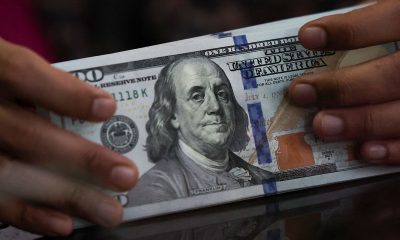Commodities
Energy & precious metals – weekly review and outlook


© Reuters.
Investing.com – If Friday’s market was any indication, oil gains could be reversed almost as quickly as they are made on news of any thawing of the crisis in the Middle East. The question though is how many hours of relative calm could there be in this conflict before the next headline of an escalation sends traders over the edge again?
More importantly, how long would it take for the oil trade to realize that practically not a single barrel has been lost to the two-week-long Israel-Hamas war to justify a higher and higher war risk premium for crude prices?
This is oil – a commodity that attains its value from demand-related consumption. Unlike gold or the dollar, it’s not a haven to keep benefiting from a mere figment of imagination that supplies are at risk and, therefore, prices have to keep rising – when the reverse is the case.
Many on Wall Street seem to think crude prices should be higher anyway due to the relative proximity of the showdown in Gaza to some of the biggest oil producers, such as Saudi Arabia, the United Arab Emirates, Iraq and Kuwait.
While Israel and Gaza themselves barely register in the global oil trade, the Strait of Hormuz straddling them is a key chokepoint for the movement of crude, where a fifth of all oil passes through its waters, seems to be their logic.
Also, the almost daily saber-rattling against Israel by the world’s fifth largest oil producer Iran – and concerns of reprisals against Tehran by the Israelis and their main ally, the United States – has added to concerns that something untoward might happen soon.
Yet, some oil traders see the conflict for what it is – a major political event without doubt, but not one that has shown any demonstrable risk so far to the crude trade.
That explains Friday’s modest pullback in crude prices after news that two prisoners held by Hamas since Oct 7 have been released on “humanitarian grounds”.
That retreat in prices came after the first thaw in the two-week-old war. But perspective is important in any situation. The Hamas gesture was super lightweight in the grand scheme of things. By the organization’s own account, there are 200 Israeli hostages in its hold and 50 more held by other armed groups in the enclave. Twenty have already been killed by Israeli air strikes, it says. Those freed do not even account for 2% of the total taken. By any stretch of logic, this isn’t going to stop the Israeli mission to wipe the militant organization off the face of Gaza.
While the notion of a regional contagion from the conflict is valid, it’s also quite a stretch at this point to maintain a near $7 to $10 risk premium on a barrel since the onset of the war – and to keep increasing it with each headline of an escalation in fighting – without commensurate impact on the trade of oil.
The pump prices of fuel in the United States now are perhaps most indicative of how the broader oil trade should be treating this crisis.
The gasoline price paid by US drivers has actually fallen – finishing Thursday at $3.554 per gallon versus $3.867 from a month ago and $3.820 a year ago.
Since crumbling from record highs of more than $5 a gallon in June 2022, gasoline at US pumps has not been able to go much beyond $3.50 due to more than adequate supply and a narrowing refining “crack” – or profit margin.
Oil: Market Settlements and Activity
New York-traded , crude for delivery in December did a final trade of $88.30 on Friday after officially settling the session at $88.08, down 29 cents, or 0.3%. WTI hit a session high of $89.85 earlier. For the week, the US crude benchmark rose 2%, adding to the prior week’s gain of around 6%.
London-traded crude for the most-active December contract did a final trade of $92.51 on Friday, after officially settling the session at $92.16, down 22 cents, or 0.2%. For the week, the global crude benchmark showed a gain of 1.4% after the prior week’s gain of 7.5%.
Oil: Technical Outlook for WTI
Immediate support for WTI stands at $87.25, a level which marks a confluence of the 5-Day EMA, or Exponential Moving Average, and Daily Middle Bollinger Band, says Sunil Kumar Dixit, chief technical strategist at SKCharting.com.
“A break below this zone will extend the decline to the horizontal support of the 100-week SMA, or Simple Moving Average, of $86.30.
For the US crude benchmark to regain upward momentum, it must hold major support at above the 50 Day-EMA of $85.30, said Dixit.
“A break below this zone will turn the momentum to bearish with potential for a retest of the 50 week EMA of $81.50.”
Consolidation above $87.25 will favor a retest of $89.85, above which WTI could be poised to take on $95 and $96.50,
Gold: Market Settlements and Activity
Gold retained its shine across the safe haven world on Friday, revisiting $2,000 for the first time since August and eventually setting a three-month high, as contagion worries from the Middle East’s latest war and the Federal Reserve’s hesitancy to raise US interest rates anymore sent a horde of investors toward the yellow metal.
“Gold’s safe haven status has been questioned on a number of occasions over recent years but times like this highlight that in times of significant uncertainty, traders look for assets with a track record,” said Craig Erlam, analyst at online trading platform OANDA.
“Of course, the circumstances are quite favorable for gold as US yields are rapidly rising at the same time, reducing Treasuries’ appeal in the short-term. But the combination of geopolitical and economic uncertainty, both of which could have implications for inflation and interest rates, is increasing gold’s appeal, for now.”
Gold’s most-active contract on New York’s Comex, December, did a final trade at $1,993.10 per ounce, after officially settling the session at $1,994.40, up $13.90, or 0.7% on the day. After an uninterrupted four-day rally, the benchmark gold futures contract finished the week up $52.90, or 2.7% – adding to the previous week’s run-up of 5.2%.
The , more closely watched by some traders than futures, settled at $1,981.64, up $7.23, or 0.4%, after a session high of $1,997.20. The spot price, which reflects real-time trades in bullion, was up 2.4% on the week, adding to the previous week’s gain of 5.4%.
Gold’s $2,000 charge came after the US and bond yields – marked by the return on the – both eased from their highs of this week, allowing the yellow metal to regain its mantle as the preferred safe haven.
Gold: Spot Price Outlook
The gold rally had successfully intercepted SKCharting’s projected target resistance of $1,998 for the spot price, Dixit noted, before the pull back to $1,974 and settling for the Day/Week at $1,981.
In the week ahead, $1,974 will act as immediate minor support, above which $1,985 will come as the first minor hurdle to clear, he said.
Trading below $1,974, however, will see gold consolidate towards $1,968 and a sustained break below $1,968 will cause an extended decline towards the $1,958-$1,954 range. Failure to hold above that range will open the way for a test of the major support zone of $1,945-$1,935.
“It is important to remember that current market mood is mainly driven by the prevailing risk on and risk off sentiments from the Middle East crisis and, as such, situations can keep evolving with crazy twists and turns,” said Dixit.
“A major bullish rally will resume on a sustained break and day close above $1,998, which will aim for $2,080 with cluster of multiple resistances at $2018-$2035-$2050 en route.”
Natural gas: Market Settlements and Activity
Things are beginning to look challenging again for the bull, after a recent turnaround from months of haplessness.
America’s favorite fuel for indoor heating and cooling returned to the $2 territory on Friday after a hold above $3 since Oct. 4. Benchmark November gas on the New York Mercantile Exchange’s Henry Hub posted a net loss of 10.4% for just-ended week, adding to the prior week’s 3.1%.
For Friday, November gas settled down 5.8 cents at $2.899
The prospects for gas weakened after a larger-than-expected addition of 97 billion cubic feet versus bets for an increase of just 80 bcf.
Natural gas: Price Outlook
Affected by resistance from the 50-week EMA, gas decline from a high of $3.47 to reach the 50-day EMA of $2.88, Dixit noted.
“Immediate resistance shifts to $3.01, a level that needs to be reclaimed, followed by $3.18, for a resumption of the bullish rebound that could retest $3.47 and challenge the 200-week SMA of $3.78 next,” he said.
“If this doesn’t happen and gas breaks below $2.87, it will open it up to a drop as low as $2.66.”
Disclaimer: Barani Krishnan does not hold positions in the commodities and securities he writes about.
Commodities
Oil prices rise; U.S. crude inventories plunge, Russia-Ukraine truce eyed
Commodities
India’s Reliance to stop buying Venezuelan oil over US tariffs, sources say
Commodities
Oil prices climb on Venezuela supply worries

 Forex3 years ago
Forex3 years agoForex Today: the dollar is gaining strength amid gloomy sentiment at the start of the Fed’s week

 Forex3 years ago
Forex3 years agoUnbiased review of Pocket Option broker

 Forex3 years ago
Forex3 years agoDollar to pound sterling exchange rate today: Pound plummeted to its lowest since 1985

 Forex3 years ago
Forex3 years agoHow is the Australian dollar doing today?

 Cryptocurrency3 years ago
Cryptocurrency3 years agoWhat happened in the crypto market – current events today

 World3 years ago
World3 years agoWhy are modern video games an art form?

 Commodities3 years ago
Commodities3 years agoCopper continues to fall in price on expectations of lower demand in China

 Economy3 years ago
Economy3 years agoCrude oil tankers double in price due to EU anti-Russian sanctions

























